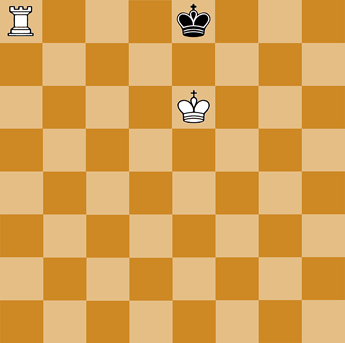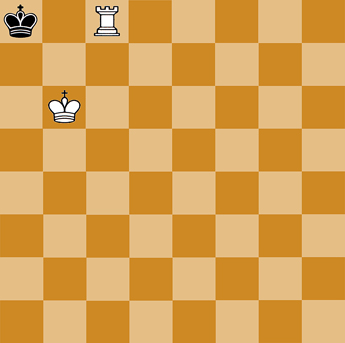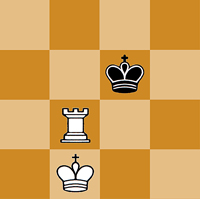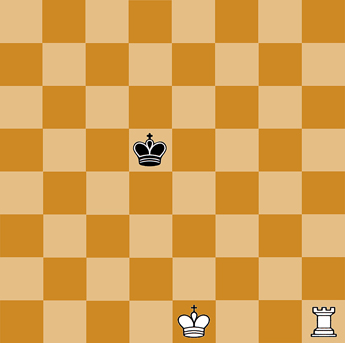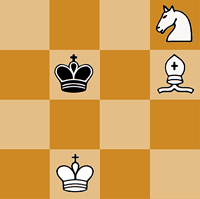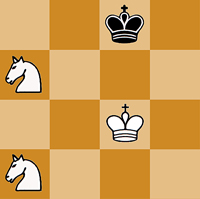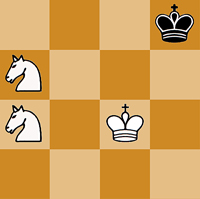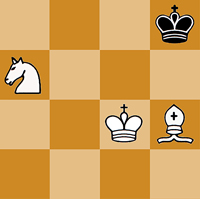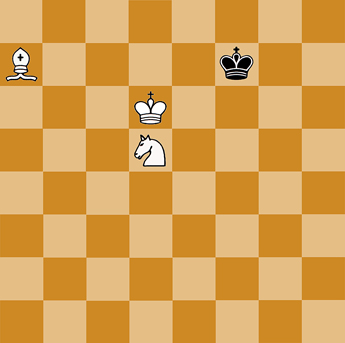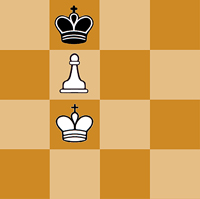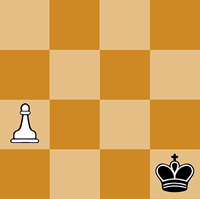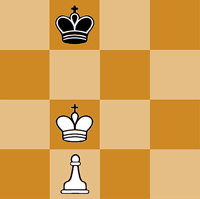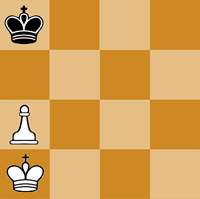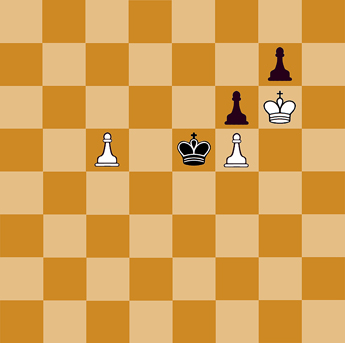|
The King has limited freedom when it comes to evading or escaping capture, and has to rely almost entirely on the help from the other pieces you have at your disposal. It is quite true that your K cannot be taken. Consequently when attacked your adversary is obligated to warn you of the impending attack by saying “check.” Your next course of action after this has happened is to immediately move your K out of check, or move it to a square that is not occupied or controlled (you cannot move to a square that puts you into check again) by the enemy. The next action if possible is to attack or take your opponents piece that is putting you in check, by your K or one of your other pieces. The last action is to, (if the position will permit) put one of your pieces between your K and the opponent’s piece that is attacking. The last action is not possible when the opponent’s piece is a Pawn or Knight. Checkmate If the game reaches a point where any action you could legally make wouldn’t get your K out of check, then it is said that you are “checkmated” and you have lost the game or your opponent has added to his/her chess trophies collection. As you can see from the following examples you cannot sacrifice your K under any circumstances, as doing so would put you into check, which is against the rules. As you can see from the first diagram the two Kings restrict each others movements by 3 squares (in exceptional cases one or two only) of the Kings region of movement. This known we see the maximum effect of K and R against the adverse K, won’t create a check if the adverse (Black King) is in the middle of the board. But if the adverse K is on the edge the maximum effect of K and R against it, creates a checkmate.
To force the Black K into one of these positions K and R of the aggressor have to cooperate, they have to drive the adverse K to the edge of the board. To do so methodically they have to restrict the adverse Kings movement so as to force him towards the edge. The opponent’s right to move is also an obligation, and the German term “Zugzwang” has been internationally adopted. The K can be forced into a position in which he must abandon his present position for a less favorable one. Take as an example the following diagram which shows only the squares that matter.
Black here restricts White as much as he can, and White has to move to a less confrontational square. The game might proceed 1 …, K-Kt1; 2 K-Kt6, K-R1; 3 R-B8, or else 1 …, K-R2; R-Kt6, K-R1; 3 K-B6, K-R2; 4 K-B7, K-R1; 5 R-R6. A similar play ensues after 1 …, K-R1; 2 K-Kt6. At the start of the drive the K and his R are not likely to be in co-operation, they may be distant from each other and from the adverse K. In that case they have to advance methodically so as to restrict the adverse K in his degree of movement and to get into touch with each other. That done the drive may begin. If for example the initial position is as follows.
White starts with R-R4, so that the R restricts the Black K, who will therefore have no opportunity of passing over Whites fourth line, provided the R maintains its guard and is protected against capture. After this the White K will hurry to the scene of action: 1 R-R4, K-K4; 2 K-K2, K-Q4; 3 K-K3, K-B4; 4 R-Q4, K-B3, 5 K-Q3, K-B4; 6 K-B3, K-B3; 7 K-B4, K-Kt3; 8 R-Q6ch. Here a check is useful but it is an exceptional case. 8 …, K-B2; 9 K-B5. The end is now in sight. The logic of the End Game K and R versus K applies also in the cases K and two B,s versus K; and K, B and Kt versus K. The reader may use the very same course of reasoning to demonstrate the following examples. For K and Kt against K no mating position exists, nor for K and B versus K. With K and two B,s the adverse K is easily forced into a mate on the edge of the board or preferably in a corner. With K and B and Kt against K, mating positions exist on the edge but the adverse K can successfully resist the attempt of being driven into such mate, with the sole exception of the corner of the same color as the B. With K and two Kts against K mating positions exist on the edge of the board, but the attempt to drive the K into such a position, always fails. To clearly show what l mean the next few diagrams are shown.
Black to play and draw.
Which is the right move for Black?
If White plays Kt-Kt5, Black is Stalemate. What other move has the same effect?
White to play and mate. White being set the task with K, B and Kt to drive the adverse K into a corner must make use of the maximum co-operation of his three pieces. The B takes affect on squares of one color only, because in moving diagonally he always dominates squares of the same color. Therefore in order not to duplicate the effect of the B, the K and Kt must work on those high squares of the adverse K that are not of the color dominated by the B. In this way the high squares of the adverse K is restricted so that he can be driven towards the edge of the board. For instance;
1 Kt-K7, K-B3; 2 B-K3. The B cuts off the high square KKt4, the Kt the squares KB4 and KKt3. The White K exerts the strongest effect due to his being in “opposition.” 2 …, K-B2; 3 K-Q7, K-B3; 4 B-B4. The movement via K4 is prevented. 4 …, K-B2; 5 B-K5, K-B1; 6 K-K6, K-K1; 7 B-B7. The Black K must be driven into the corner KR8 dominated by the B. 7 …, K-B1; 8 Kt-B5, K-K1; 9 Kt-Kt7 ch., K-B1; 10 K-B6, K-Kt1; 11 K-Kt6, K-B1; 12 B-Q6 ch., K-Kt1; 13 Kt-B5, K-R1; 14 B-R3, K-Kt1; 15 Kt-R6 ch., K-R1; 16 B-QKt2 mate. The Pawn, itself weak, gains tremendous power by advancing to the eight rank where it is promoted to a piece of its own color. King and Pawn in conjunction can deprive the adverse King of its ability to move, but they cannot mate him.
Black, to play, stops the Pawn. White, to play, advances and thereafter Queens the P. If the K succeeds in reaching the file of the pawn in time the P will need the support of his K in order to fight against the adverse K. It is then advantageous for the pawn to have his own K in front because the powerful opponent is best combated by an equally powerful ally. Hence in the following position White wins. Or your oppent add's to his/her chess trophies collection
White or Black to play. White wins. If White to play, the game takes the course; 1 K-B6, K-B1; 2 P-Kt6; K-Kt1; P-Kt6, 3 P-Kt7. Black is now in “Zugzwang” K-R2. 4 K-B7. The K thus guards the square Kt8 and queens the pawn in safety. If Black to play, White wins more quickly still; 1 …, K-B1; 2 K-R7, and the pawn now advances easily. But the following position leads to a stale-mate and therefore a draw.
White or Black to play. Black draws. 1 K-B6, K-B1; 2 P-K7 ch., K-K1. Now White must move the King. If he goes to K6 Black is stalemate; if he moves elsewhere Black captures the pawn. The power of the “passed pawn” in an ending may be illustrated in a large variety of ways. Here are a few examples;
White to play and win. White wins by advancing his P, the Black K is thereby forced away from the scene of action. Although he can capture the passed pawn, this cannot prevent disaster on the right wing, where the White K captures the two Black pawns and Queens his remaining P.
White fights the black R by R-B8. Whether the Black R takes the White R or refuses to capture, the White P will Queen.
White K on KR6, P on KR5, Black K on KR1. White cannot win, the game ends in a stalemate. Add a White B on KB1 to the White force, the Black K will still be able to hold the KR square and will therefore prevent the White P from Queening, and thus draw, but with a White Kt on any indifferent square, say KB1, or a B which can command the Queening square, White will be able to drive the Black K out of the corner and win. White K on KB5, P on Q5, Black K on KB2, P on Q3, White with the move can only draw. Black with the move is under “Zugzwang,” i.e. forced to abandon the opposition and finally loses, 1 …, K-K2; 2 K-Kt6, K-K1; 3 K-B6, K-Q2; 4 K-B7, “Zugzwang” again! Black at last loses his QP. The reader should experiment with similar game endings of his own making.
|
